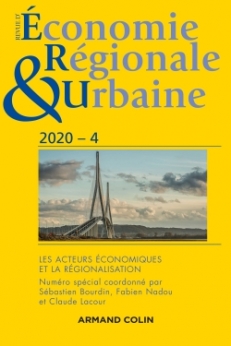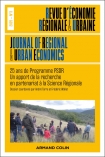
Revue d'économie régionale et urbaine (4/2020)
Pour acheter ce numéro, contactez-nous
Recevez les numéros de l'année en cours et accédez à l'intégralité des articles en ligne.
Dans le cadre général de la convergence entre approches formelles et qualitatives, l’article présente la vision et le style de recherche en science régionale qui ont caractérisé les longues années de coopération des deux auteurs, toujours à la recherche d’outils conceptuels capables d’interpréter au mieux la complexité de la réalité. Les auteurs sont particulièrement convaincus que les approches évolutives sont nécessaires à l’interprétation des systèmes économiques régionaux et urbains complexes. Les deux auteurs sont également convaincus que la compétitivité à long terme est un phénomène d’offre, basé sur des actifs matériels et immatériels comme cela a pu être mis en évidence tout au long de soixante années de théorisation scientifique régionale. Tous ces éléments ont été synthétisés dans le concept de capital territorial, et ont appelé à une utilisation complémentaire et synergique de ses différents actifs et à leur développement équilibré. Toutes ces convictions ont conduit les deux auteurs à l’idée qu’une approche moderne de la croissance régionale appelle la mise en oeuvre de théories de la croissance régionale basées sur un espace relationnel stylisé, par une intégration entre les processus nationaux, macroéconomiques et les atouts et spécificités territoriales, ce qui n’a guère été pris en considération dans la science régionale jusqu’à présent. Le document présente un premier modèle formalisé de ce type.
If the formalization of space and time in regional economic models has gone through decisive improvements, what has always been, and still is, a difficult step forward in the conceptualization of a modern regional science is the convergence between the formalized, analytical approaches with the qualitative, conceptual ones that have enriched regional economics since the 1970s, moving the main focus of analysis from “space” to “territory”. Within the general goal of moving towards a convergence between formalized and qualitative approaches, the paper presents the view and the research style in regional science that characterized the long lasting years of cooperation of two authors, always in search for conceptual tools able to interpret the complex reality at best. In particular, authors are convinced that evolutionary approaches are necessary for the interpretation of complex regional as well as urban economic systems. The authors developed new theoretical views characterized by an evolutionary approach and by sound empirical evidence. Moreover, the two authors are convinced that long run competitiveness is a supply side phenomenon, based on tangible and intangible assets indicated along sixty years of regional science theorisation. All these elements have been synthetized in the concept of territorial capital, and have called for a complementary and synergic use of its different assets and their balanced development. All these convictions led the two authors to the idea that a modern approach to regional growth calls for the implementation of regional growth theories based on a relational-stylised space, through an integration between national, macroeconomic processes and territorial assets and specificities, something that has hardly been taken into consideration in regional science up to now. The paper presents a first formalized model of this kind.
